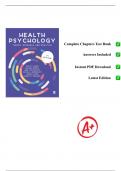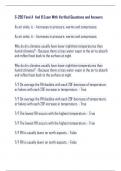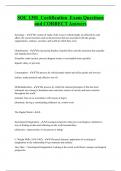✅
Complete Chapters Test Bank
Answers Included
Instant PDF Download
Latest Edition
, TABLE OF CONTENTS
PART I HEALTH PSYCHOLOGY IN THE CONTEXT OF HUMAN
BIOLOGY AND SOCIETY
1 Health Psychology: An Introduction
2 The Nervous, Endocrine and Immune Systems, and the Principle of
Homeostasis
3 Genetics, Epigenetics and Early Life Development
4 Macrosocial Influences
5 Social Justice and Health
6 Culture and Health
PART II THEORIES, MODELS AND INTERVENTIONS FOR
HEALTH BEHAVIOUR CHANGE
7 Theories, Models and Interventions for Health Behaviour
Change
8 Sexual Health
9 Food, Eating and Obesity
10 Alcohol and Drinking
11 Smoking and Vaping
12 Physical Activity and Exercise
PART III HEALTH PROMOTION AND DISEASE PREVENTION
13 Information, Communication and Health Literacy
14 Screening and Immunisation
15 Health Promotion
16 Stress and Disease Prevention
17 Preventing the Spread of Disease: The COVID-19 Pandemic PART
IV ILLNESS EXPERIENCE AND HEALTH CARE
18 Pregnancy, Parenting and Health
19 Gender Affirmative Health Care
20 Pain and Pain Control
21 Cancer
22 Coronary Heart Disease
23 HIV Infection and AIDS: Tackling Stigma and Victim Blaming
24 Long-Term Conditions: The Examples of Diabetes and ME/CFS
25 End-of-Life Care, Dying and Death
, Test Bank
Marks et al., Health Psychology: Theory, Research and Practice, 7e
2024
Multiple choice questions
Chapter 1: Health psychology: An introduction
1. In the definition given in this book, health psychology is defined as an ______ field.
a. international
b. interdisciplinary
c. interactive
d. interesting
Ans: B
2. The leading risk factor for global disease burden in 2002 was:
a. alcohol
b. childhood and maternal underweight
c. tobacco
d. high blood pressure
Ans: B
3. According to the textbook, a psychological approach in the absence of environmental
change is like:
a. whistling in the wind
b. an excellent idea
c. revolutionary and ingenious
d. a breath of fresh air
Ans: A
, Lecturer Resources
Marks et al., Health Psychology: Theory, Research and Practice, 7e
2024
4. According to S.S. Stevens, measurement is the assignment of numbers to attributes
according to:
a. formulae
b. size
c. rules
d. quality
Ans: C
5. According to Michell, before quantification can happen, it is first necessary to obtain
evidence that the relevant attribute is quantitative in ______
a. structure
b. stature
c. status
d. studies
Ans: A
6. When findings are difficult to generalize to the world outside of the laboratory, we say the
research is lacking in ______ validity
a. ecological
b. economical
c. empirical
d. experimental
Ans: A
7. The ‘Health Onion’ is an example of a:
a. paradigm
, Lecturer Resources
Marks et al., Health Psychology: Theory, Research and Practice, 7e
2024
b. model
c. theory
d. framework
Ans: D
8. In this chapter, evidence-based practice (EBP) is likened to:
a. slicing an onion
b. filtering coffee
c. making wine
d. baking bread
Ans: B
9. More research is necessary to confirm the assumption that ______ cause positive changes
to quality of life.
a. lifestyle changes
b. research findings
c. survey data
d. questionnaire responses
Ans: A
10. ______ have some of the characteristics of paradigms (Kuhn, 1970) as they refer to a
complete system of thinking about a field of inquiry.
a. pathways
b. theories
c. frameworks
d. models
Ans: C
, Lecturer Resources
Marks et al., Health Psychology: Theory, Research and Practice, 7e
2024
11. Fill in the missing word: Health is a state of well-being, wants and needs based on the
satisfaction of biological, psychosocial, cultural, ______, political, social justice and
spiritual wants and needs, not simply the absence of illness.
a. economic
b. educational
c. environmental
d. experiential
Ans: A
12. The hierarchy of needs was proposed by:
a. Murray
b. MacDonald
c. Marks
d. Maslow
Ans: D
13. In the hierarchy of needs, the most basic level is defined as:
a. safety
b. belonging
c. esteem
d. physiological
Ans: D
14. In the hierarchy of needs, the highest level was defined as:
a. safety
b. belonging






